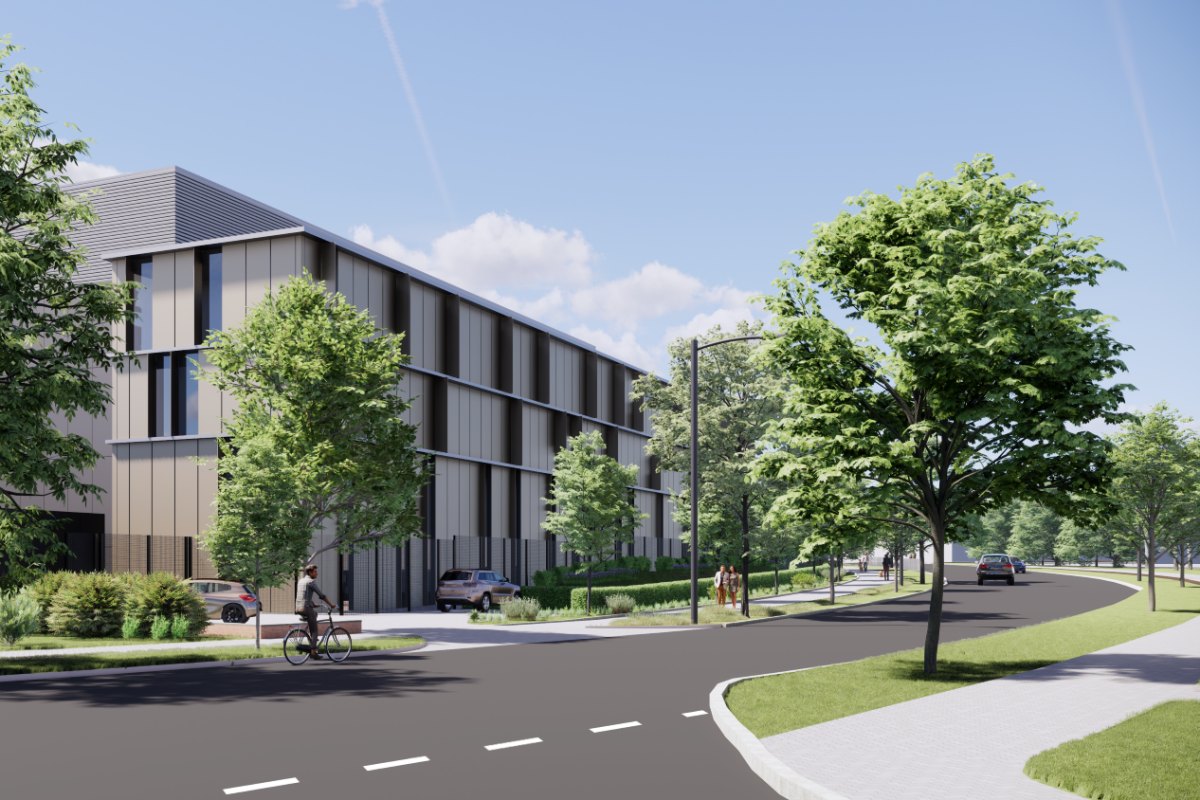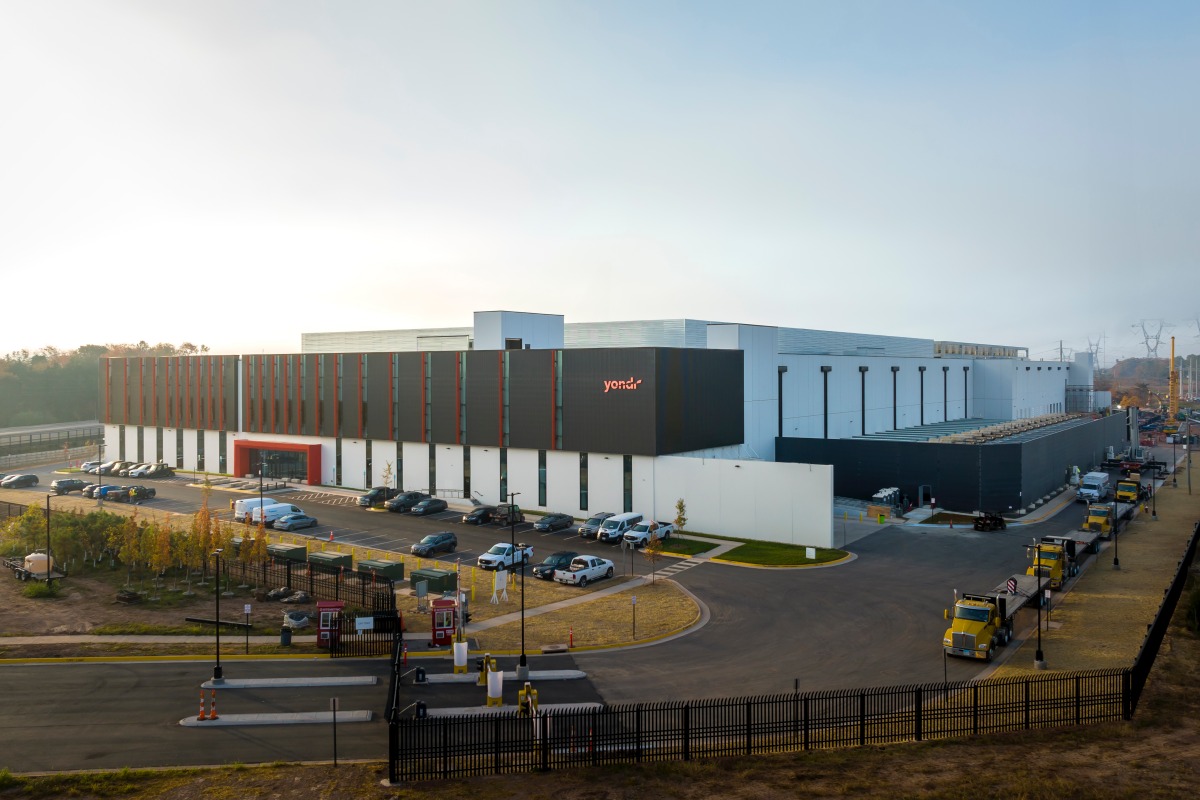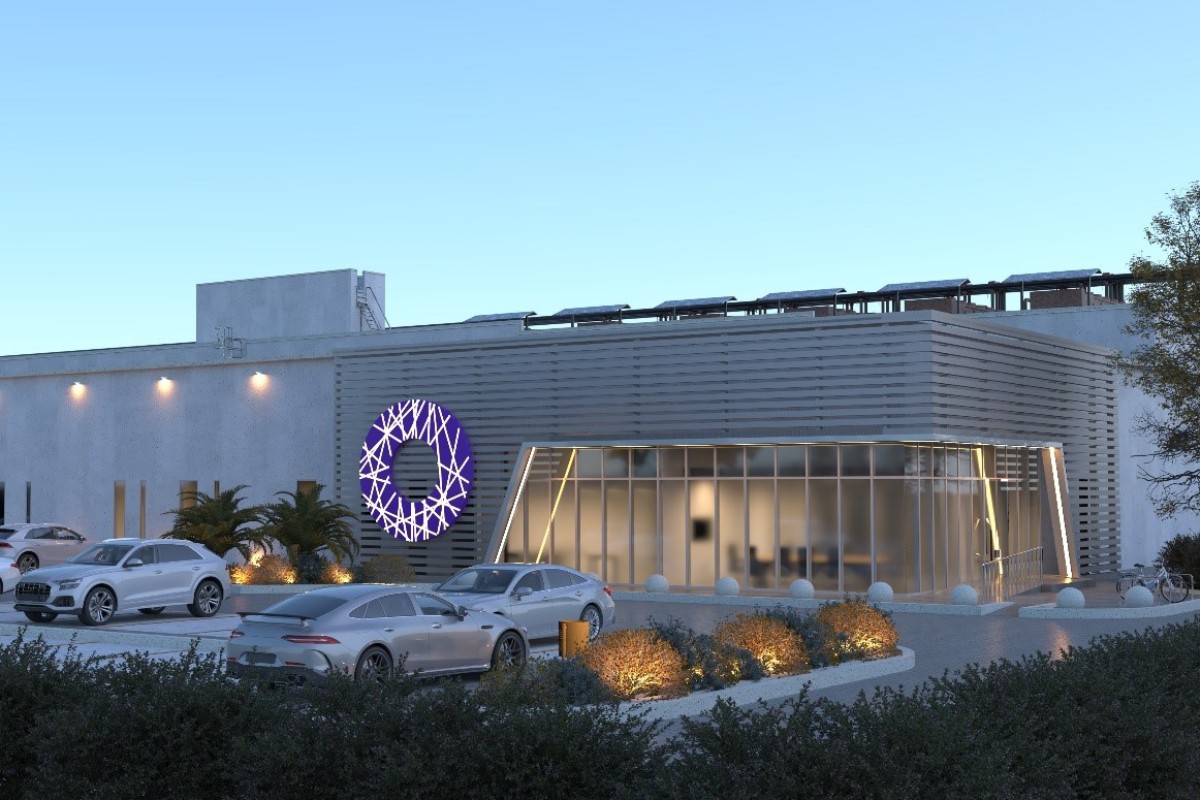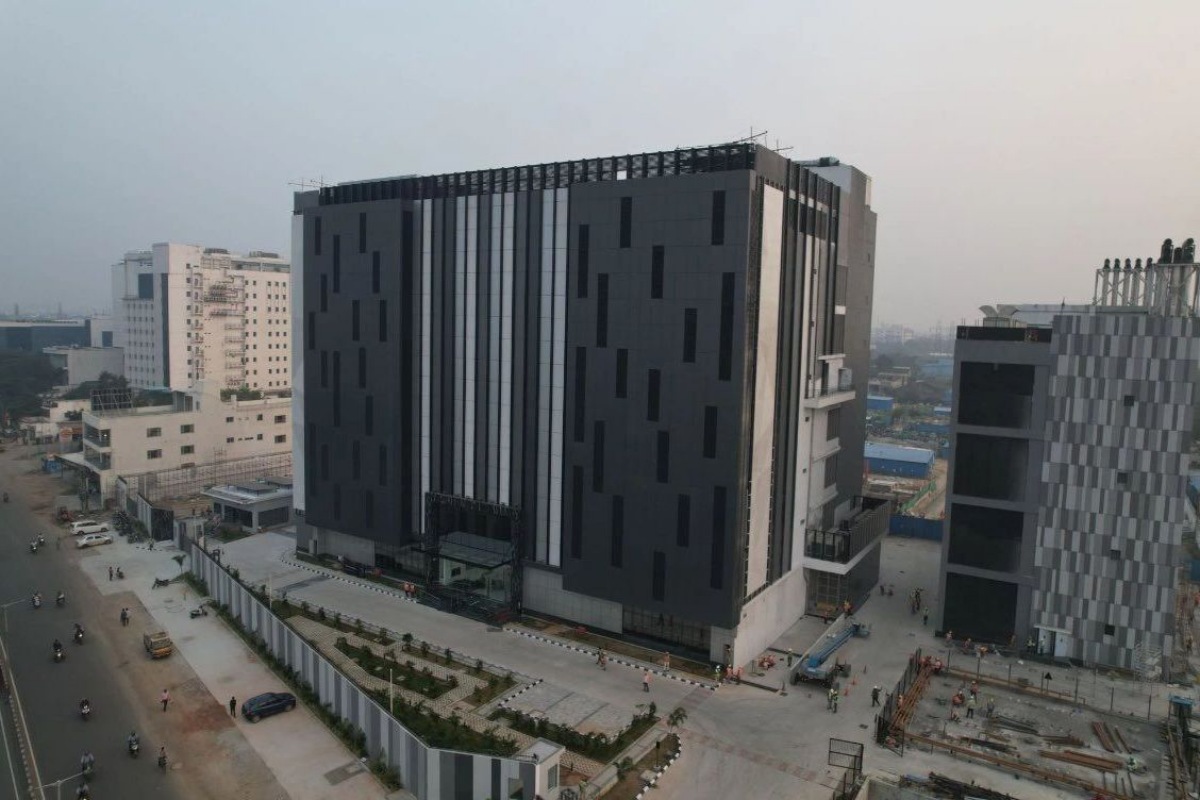Data Centre Build News & Insights
Data Centre Architecture Insights & Best Practices
Data Centre Build News & Insights
News
Planning approved for new DC in Hertfordshire, UK
Outline planning has been approved for a new 5,000 m² data centre at 45 Maylands Avenue in Hemel Hempstead, Hertfordshire, UK.
Designed by architecture firm Scott Brownrigg for Northtree Investment Management, the new project is intended to provide much-needed digital infrastructure while creating a new, high-quality workplace and public realm.
Proposals seek to maximise space on the industrial site by replacing an existing two-storey warehouse and office building with a new three-storey facility, adorned with office accommodation, a substation, car parking, and servicing areas.
The architectural company says designs echo the scale of neighbouring logistics and light industrial buildings, using a contemporary architectural language and high-quality materials to "enhance the frontage to Maylands Avenue."
Existing levels on the site will be utilised to maximise available space while reducing the height of the building facing the street.
The current access from Maylands Avenue will be enhanced to provide accessible parking and a point of arrival for guests, pedestrians, and those arriving by bicycle, while access from Cleaveland Way will be gated and dedicated to HGV and staff vehicles.
A setback from the roadside creates an opportunity to reinforce the boulevard and improve the quality of the public realm along Maylands Avenue. New landscaping with seating areas hopes to encourage pedestrian and cycle movement and contribute to the visual amenity on the estate.
The sustainability strategy includes measures such as a fabric-first approach for the design, as well as a layout that allows for naturally ventilated offices via openable windows, while maintaining the security of restricted spaces.
A mixture of locally native trees and shrub species will be planted along the boundaries to the south and west of the site to create a vegetative buffer for the development and habitat for local wildlife.
Scott Brownrigg claims its proposal for 45 Maylands Avenue is set to make the most of the site available, densifying industrial land use, whilst carefully considering how the occupied spaces can positively contribute to and improve upon the existing street scene.
Joe Peck - 29 August 2025
Data Centre Build News & Insights
Data Centres
News
Techno Digital unveils hyperscale data centre in Chennai
Techno Digital, the digital infrastructure arm of Techno Electric & Engineering Company Limited (TEECL), today announced the inauguration of its 36MW data centre at SIPCOT IT Park, Siruseri, Chennai. This next-gen facility is part of Techno Digital’s $1 billion investment commitment towards building future-ready, sustainable digital infrastructure across the country.
Spanning over 200,000 square foot, the state-of-the-art 36MW data centre delivers a hosting capacity of about 2,400 high-density racks and is designed to support flexible power densities from 10 kW to 50 kW per rack and beyond, making it one of India’s most advanced AI-ready infrastructures. Strategically located in the heart of Chennai’s IT corridor, the facility is designed to provide resilience against climate risks and offers seamless connectivity to multiple cable landing stations and domestic networks that anchor India’s internet backbone.
The facility’s design integrates:
On-site 110 kV GIS Substation with dual power feeds from independent substations, connected via underground cable paths for reliability and weatherproof operation.
Powering customers’ critical IT load within server hall via state-of-the-art UPS systems, tested and certified with NVIDIA’s latest GB200 series.
Efficient Cooling Architecture featuring centrifugal water-cooled chillers and adiabatic cooling towers, thus enabling best-in-class operational PUE and helping reduce water consumption by 75%.
Ankit Saraiya, Director & CEO, Techno Digital, says, “Our Chennai AI-ready hyperscale data centre is a significant milestone in our commitment to accelerating the Digital India vision and advancing India’s self-reliance initiative. This launch goes beyond infrastructure; it represents a strategic investment in building a future-ready digital ecosystem.
“Chennai stands out as a top destination for hyperscale data centres, due to its robust infrastructure, progressive business policies, and vibrant talent pool. This, coupled with our strong credentials in power infrastructure, strategically positions us as a partner of choice for enterprises looking to modernise, scale, embrace sustainability and future-proof their digital operations.”
India’s burgeoning digital economy demands a comprehensive focus on building a robust digital infrastructure. With the rise in data consumption, rapid cloud adoption, and advancements in AI and 5G rollout, data centres are the strategic pillars that deliver scalable, secure, and efficient solutions to meet this demand. Additionally, as sustainability is becoming a key factor in India’s growth trajectory, optimising energy-efficient resources for modern hyperscale and edge data centres is of utmost importance.
“We are thrilled to announce the launch of our AI-ready hyperscale data centre in Chennai, a facility that exemplifies progressive technology, precision engineering, and purposeful innovation, built at the intersection of tradition and technology,” comments Amit Agrawal, President, Techno Digital. “Today’s digital-native enterprises demand hyper-availability, seamless scalability, robust security, and operational resilience, all while advancing their sustainability goals. We are confident that the strategically located facility on India’s southern coast in Chennai, further augmented by our network of interconnected Edge data centres, is well poised to shape the country’s digital infrastructure with sustainable, AI-driven, and cloud-optimised offerings.”
Padam Prakash Gupta, Managing Director, TEECL, adds, “With this strategic expansion, Techno Electric reaffirms its commitment to building a high-quality, benchmark digital infrastructure platform. The Chennai Data Centre facility is a testament to the group’s EPC leadership and financial discipline, ensuring superior returns and long-term value creation for all stakeholders.”
The facility sets a new benchmark for sustainable digital infrastructure by deliberately allocating 25% of the total site area to green spaces - a first in the region. It incorporates adiabatic cooling towers and an energy-efficient exterior that reduce water consumption and minimise heat gain. Additionally, facility is equipped with advanced water treatment, recycling, and storage systems to ensure responsible usage and reuse of water. The design aligns with a Rated 3+ reliability standard and is confirmed for USGBC Gold certification for its environmental performance.
For more from Techno Digital, click here.
Simon Rowley - 28 August 2025
Data Centre Architecture Insights & Best Practices
Data Centre Build News & Insights
Data Centre Projects: Infrastructure Builds, Innovations & Updates
News
Yondr to build 550MW Dallas campus
Yondr Group, a global developer, owner, and operator of hyperscale data centres, has secured a 163-acre site just south of Dallas in Lancaster, Texas, USA, to develop a campus with the capacity to accommodate 550MW critical IT load. The project is situated in one of the nation’s most sought-after data centre corridors.
The acquisition is Yondr’s first announced expansion under its newly appointed CEO, Aaron Wangenheim. The Dallas site joins Yondr’s growing North American footprint, which includes two data centres totalling 96MW in Northern Virginia and a 27MW data centre in Toronto, Canada.
The company is reportedly also in advanced discussions for sites in several other tier one US metros, and continues to expand in Europe, where the company has existing assets in London, Frankfurt, and Amsterdam.
“The US is a key market for Yondr’s next phase of growth and Dallas is one of the largest and fastest-growing data centre markets in the world. This investment in Dallas is just the beginning,” says Aaron Wangenheim, CEO of Yondr.
“Our proven ability to deliver reliable, resilient, and sustainable data centre solutions at scale – backed by the strength of our investors DigitalBridge and La Caisse – positions us incredibly well to support clients in tier one markets where they need us.”
In addition to job creation, the project should generate large tax revenue for the region and open opportunities for local suppliers and contractors throughout construction and operations.
Mayor Clyde Hairston of the City of Lancaster comments, "We are delighted to welcome Yondr, a respected data centre developer and operator, to Lancaster. Yondr has pledged to create full-time jobs as a result of this project and [to] provide significant financial support for local events and community initiatives.
“As Lancaster continues to rise as a shining star of Texas, Yondr’s investment further solidifies our city’s place on the map as a hub for innovation, infrastructure, and opportunity. We look forward to seeing their campus take shape and their impact flourish within our community."
The campus is expected to break ground in 2026.
For more from Yondr Group, click here.
Joe Peck - 20 August 2025
Data Centre Build News & Insights
Data Centre Business News and Industry Trends
Data Centre Projects: Infrastructure Builds, Innovations & Updates
Insights into Data Centre Investment & Market Growth
AirTrunk secures S$2.25bn green loan for Singapore DC
Hyperscale data centre specialist AirTrunk has secured a S$2.25 billion (£1.3 billion) green loan in Singapore to finance its new hyperscale data centre, SGP2. The deal is Singapore’s largest-ever loan (and green loan) for a data centre project.
The transaction supports the development of sustainable digital infrastructure and reinforces Singapore’s position as a major green finance hub in Asia. The loan aligns with the Technical Screening Criteria of the Singapore-Asia Taxonomy for Sustainable Finance, as well as AirTrunk’s Green Financing Framework.
Largest green loan for a data centre in Singapore
Crédit Agricole CIB, DBS Bank, and ING Bank acted as global coordinators and sustainability structuring agents for the financing, working alongside a consortium of 23 other financial institutions.
MUFG Bank, Natixis CIB, Standard Chartered Bank (Singapore), and United Overseas Bank were among the mandated lead arrangers.
The financing begins as a green loan, with the option to transition into a sustainability-linked loan (SLL). All financial incentives will be directed to AirTrunk’s social impact fund.
Robin Khuda, Founder and Chief Executive Officer at AirTrunk, comments, “This landmark transaction – Singapore’s largest loan and green loan for a data centre – strengthens AirTrunk’s leadership in sustainable finance and reflects strong market confidence in AirTrunk’s growth and sustainability strategy.
"This financing structure highlights the strength, depth, and international scale of Singapore’s financial ecosystem.”
AirTrunk’s SGP2 campus, located in Loyang, will provide more than 70MW of cloud and artificial intelligence compute capacity for Singapore and Southeast Asia.
The facility is designed to achieve a BCA Green Mark Platinum rating and a Power Usage Effectiveness (PUE) of 1.20, one of the lowest in Singapore. Green concrete and green steel are also being used in construction to cut embodied carbon.
For more from AirTrunk, click here.
Joe Peck - 18 August 2025
Data Centre Build News & Insights
Data Centres
News
Renewables and Energy: Infrastructure Builds Driving Sustainable Power
Equinix explores new energy sources for DCs
Equinix, a digital infrastructure company, is working with alternative energy providers to secure reliable electricity for its global network of AI-ready data centres, including facilities in Europe.
The company’s diversified energy strategy combines traditional utility arrangements with new on-site power generation, fuel cells, and next-generation nuclear energy.
According to the International Energy Agency, global electricity demand is forecast to rise by 4% annually through 2027, driven by electrification, artificial intelligence, and industrial growth. This increase is placing pressure on utilities and ageing grids, highlighting the need for new energy infrastructure to support expanding data centre operations.
Equinix says it is investing in grid upgrades with utility partners, including new substations and backup systems designed to improve reliability during outages.
The company is also expanding its use of fuel cells and natural gas for on-site generation, while supporting the development of advanced nuclear technologies to provide clean, stable power in the future.
“Access to round-the-clock electricity is critical to support the infrastructure that powers everything from AI-driven drug discovery to cloud-based video streaming,” says Raouf Abdel, Executive Vice President of Global Operations at Equinix.
“As energy demand increases, we believe we have an opportunity and responsibility to support the development of reliable, sustainable, scalable energy infrastructure that can support our collective future.”
Equinix has signed agreements with several nuclear developers:
• Oklo – Agreement to procure 500MW from next-generation Aurora fast reactors• Radiant – Preorder of 20 Kaleidos microreactors, designed for rapid deployment• ULC-Energy with Rolls-Royce SMR – Letter of Intent for up to 250MWe in the Netherlands• Stellaria – Agreement for 500MWe using molten salt Breed & Burn technology
Equinix has also expanded its use of advanced fuel cells through a long-term agreement with Bloom Energy, covering more than 100MW across 19 US data centres.
Ali Ruckteschler, Senior Vice President and Chief Procurement Officer at Equinix, comments, “The potential challenges to powering reliable and sustainable digital infrastructure are considerable.
"However, Equinix has always been at the forefront of energy innovation, signing the data centre industry’s first agreement with a SMR provider and pioneering the use of fuel cells a decade ago.”
Equinix says it remains committed to sourcing 100% renewable energy by 2030 and reported 96% global renewable coverage in 2024, with 250 sites already running entirely on clean energy.
The company is also expanding the use of liquid cooling technologies and adopting ASHRAE A1 Allowable standards to improve operational efficiency.
For more from Equinix, click here.
Joe Peck - 18 August 2025
Data Centre Build News & Insights
Data Centre Projects: Infrastructure Builds, Innovations & Updates
Data Centres
News
ODATA opens fourth hyperscale DC in Mexico
ODATA, a Latin American data centre provider and part of Aligned Data Centers, has launched its QR04 hyperscale data centre near San Miguel de Allende in the Querétaro region.
The facility expands ODATA’s network in Mexico to four interconnected sites, designed to support the increasing demand for cloud computing and artificial intelligence services.
The interconnected model allows customers to operate across multiple locations with built-in redundancy, supporting reliable cloud and AI operations.
The company has focused on addressing one of Mexico’s key infrastructure challenges - namely consistent power supply - to strengthen its position in the country’s hyperscale market.
“With QR04, we reaffirm our investment in Mexico and our commitment to our global customers,” says Ricardo Alário, CEO of ODATA. “Our expanded regional presence provides a solid foundation for the sustained growth of cloud and artificial intelligence in the country as well as across Latin America.
"Just three months after inaugurating DC QR03, we’ve already begun expanding that facility and have launched DC QR04. Our continued investment across all our campuses demonstrates our commitment to staying ahead of the curve and anticipating the technological needs of the future.”
QR04 has a planned total IT capacity of 24MW, with the first 12MW now operational. It features Aligned Data Centers’ patented Delta Cube (Delta³) air-cooling system, designed to maximise thermal efficiency and support power densities of up to 50kW per rack using air cooling alone.
The system captures and removes heat at source rather than distributing cold air through the data hall, and can be integrated with liquid cooling for high-density AI, machine learning, and high-performance computing workloads.
The site also uses a closed-loop water cooling system, enabling continuous water reuse and minimising environmental impact whilst maintaining a low Water Usage Effectiveness (WUE).
The facility is already in service for hyperscale customers, reflecting growing demand for high-density data infrastructure in Mexico. Its construction has reportedly created more than 1,500 local jobs.
For more from ODATA, click here.
Joe Peck - 15 August 2025
Data Centre Architecture Insights & Best Practices
Data Centre Build News & Insights
Data Centres
News
DC BLOX secures $1.15bn for Atlanta data centre
DC BLOX, a provider of connected data centres and fibre networks, has announced that it has closed $1.15 billion (£858 million) in green loan financing for the construction of a data centre campus in Douglas County, Georgia, USA.
The funds will support the development of a 120 MW data centre and include campus expansion to support an additional 80 MW, available in 2027.
“Securing this capital confirms confidence in our execution track record,” comments Melih Ileri, SVP of Capital Markets & Strategy at DC BLOX.
“Continuing to deliver our projects on time and with excellence has earned us the trust of our customers and investors, leading to this historic growth in our business.”
This project comes on the heels of recently announced DC BLOX projects including multiple hyperscale edge nodes across the US Southeast.
With additional hyperscale-ready data centre capacity available in Conyers and Douglasville, Georgia, DC BLOX believes it is set to rapidly expand its presence around Atlanta.
“With this latest project announcement, DC BLOX continues to deliver on its mission to build the foundational digital infrastructure needed to drive the Southeast’s growing economy,” claims Jeff Uphues, CEO of DC BLOX.
“Atlanta is the fastest-growing data centre market in the US today and we are proud to enable our customers to expand their footprint in our region.”
This financing follows the prior $265 million (£197.5 million) green loan secured from industry lenders, as well as the growth equity that was committed by Post Road Group in the fourth quarter of 2024.
“The DC BLOX management team has done a terrific job positioning the business for success in the Southeast, with a consistent focus on serving the customer and community,” says Michael Bogdan, Managing Partner at Post Road Group.
“We are thankful to all our capital partners who have helped capitalise the company to meet the tremendous hyperscale and edge growth the company has experienced.”
Those involved in the deal
• ING Capital served as Structuring and Administrative Agent• ING, Mizuho Bank, and Natixis Corporate & Investment Banking (Natixis CIB) served as Initial Coordinating Lead Arrangers and Joint Bookrunners• First Citizens Bank served as Coordinating Lead Arranger• CoBank ACB, LBBW New York Branch, The Toronto-Dominion Bank New York Branch, and KeyBank National Association served as Joint Lead Arrangers• The Huntington National Bank served as Mandated Lead Arranger• ING and Natixis CIB also served as Joint Green Loan Coordinators• A&O Shearman served as counsel to DC BLOX• Milbank served as counsel to the lenders
For more from DC BLOX, click here.
Joe Peck - 12 August 2025
Data Centre Build News & Insights
Data Centres
Renewables and Energy: Infrastructure Builds Driving Sustainable Power
Sustainable Infrastructure: Building Resilient, Low-Carbon Projects
Why data centres should care about atmospheric chemistry
Data centres are multiplying to satisfy the world’s appetite for computational power, driven by AI and other emerging technologies. The outcome has been an unprecedented surge in energy demand and greenhouse gas (GHG) emissions.
Here, Alexander Krajete, CEO at emissions treatment specialist Krajete, explains why data centres must look beyond their direct carbon footprint and adopt a holistic approach to multi-emission capture and valorisation:
What's changed?
Data centres once had a modest footprint, accounting for under 1% of global GHG emissions, according to the International Energy Agency. But rising demand from AI, streaming, and blockchain is set to more than double their energy use from 415 TWh in 2024 to 945 TWh by 2030.
Some tech giants share these predictions. Google stated in its 2024 Environmental Report that “in spite of the progress we're making, we face significant challenges that we’re actively working through. In 2023, our total GHG emissions increased 13% year-over-year, primarily driven by increased data centre energy consumption and supply chain emissions.”
A holistic approach to data centre sustainability
Some leading tech companies claim to have purchased or generated enough renewable electricity to match 100% of their operational energy consumption.
As the IEA notes, buying renewable energy or certificates doesn’t guarantee a data centre runs on clean power 24/7 due to the intermittency of renewables and potential mismatches in location or grid.
A more accurate, holistic calculation also includes indirect emissions throughout the supply chain — the so-called scope three emissions.
These include mining raw materials like copper, silicon, and lithium - used in a data centre’s server racks - or the production of building materials like aluminium, steel, and concrete.
Complying with new sustainability regulations
Although not specifically aimed at data centres, the EU’s Corporate Sustainability Reporting Directive (CSRD) requires organisations, including tech companies, to report on their sustainability performance, including scope one, two, and three emissions.
In addition, in 2024, the European Commission adopted legislation specifically aimed at “establishing an EU-wide scheme to rate the sustainability of EU data centres.”
To comply with these new legal obligations, data centre operators must examine their environmental footprint holistically.
Why atmospheric chemistry matters to data centres
Although reducing the amount of CO2 in the atmosphere remains vital, we must also address other gases that can harm our ecosystems and climate.
These chemicals include nitrogen oxides (NOX), carbon monoxide (CO), hydrogen sulphide (H2S), sulphur oxides (SOX), hydrocarbons, and various metals. Once released, these gases can react with one another, leading to secondary pollutants.
The consequences of these are yet to be fully understood. They originate from combustion-heavy sectors like mining, cement, and energy, all contributors to scope two and three emissions.
Traditionally, there have been two ways of capturing atmospheric pollutants.
Take CO2 as an example. The sacrificial method uses limestone to remove CO2 and other gases, creating non-reusable carbonates. The regenerative amine-based method produces reusable amine carbamates but emits harmful, amine-based degradation products.
Advanced adsorption is a low-energy, low-emission regenerative process that captures and valorises emissions at temperatures below 100°C, far lower than the 150–200°C required for amine-based methods.
Pollutant gases weakly bind to a complex inorganic filter, allowing for easy separation. It can be applied at the exhaust point of any combustion process, such as cement factory chimneys or stationary diesel engines.
By supporting the adoption of advanced adsorption technology throughout their supply chains, data centres can address their scope two and three emissions more effectively and meet their sustainability goals.
Multi-emission capture is the key to sustainable data centres
Thanks to innovative technologies like advanced adsorption, we can go beyond capturing and neutralising pollutants like nitrogen oxides. We can also transform these emissions into valuable by-products like fertilisers, supporting a circular economy.
As the world’s insatiable demand for data grows, data centres must adopt holistic sustainability strategies that withstand the test of time. Multi-emission capture must be part of the solution, enabling data centres to balance the growing need for powerful AI with the needs of our planet.
Joe Peck - 11 August 2025
Data Centre Build News & Insights
Data Centre Infrastructure News & Trends
Data Centre Projects: Infrastructure Builds, Innovations & Updates
Innovations in Data Center Power and Cooling Solutions
Joule, Caterpillar, Wheeler to power Utah DC
Joule Capital Partners, an infrastructure company, Caterpillar, a manufacturer of construction equipment, and Wheeler Machinery, a dealer of heavy construction equipment, have jointly announced an agreement to power Joule’s High Performance Compute Data Center Campus in Utah.
Joule says it aims to create the largest single campus in Utah.
Bringing multiple gigawatts of capacity to Utah
This initiative will provide four gigawatts of total energy to the centre of the Intermountain West.
The project will deliver prime power and integrated combined cooling heat and power (CCHP) systems with a by-design liquid cooling architecture.
Powered by a fleet of Caterpillar’s latest G3520K generator sets and support equipment, the distributed generation system produces electricity and captures waste heat to power and cool high-density server systems.
The provision includes 1.1 gigawatt hours of grid forming battery energy storage along with backup power generation served by diverse fuel sources.
Due to Caterpillar’s US-based manufacturing footprint, the full generation package should be able to be delivered ahead of other generation technologies. This speed-to-power advantage could be critical for meeting the growth in demand for compute capacity.
Beyond the gensets, this integrated system includes the controls, switchgear, inverters, energy storage, and CCHP, providing a total power provision for the Joule data centre.
Caterpillar and Wheeler will also provide service and support for the products and systems, aiming to ensure uptime and availability targets are met.
Comments
“This project represents the core of Joule’s mission: to deliver artificial-intelligence-(AI)-ready compute capacity by pairing world-class data centre campuses with reliable, on-demand power,” says David Gray, President of Joule Capital Partners.
“By combining Caterpillar’s advanced energy systems with Wheeler’s local expertise, we can bring gigawatt-scale capacity to market faster and more efficiently than ever before, ensuring our tenants have the power and reliability they need to thrive in the next generation of high-performance computing.”
Melissa Busen, Senior Vice President of Electric Power at Caterpillar, adds, “Caterpillar is uniquely positioned to tackle the growing energy needs for artificial intelligence and the evolving needs of modern infrastructure.
"This project is a perfect example of how we can deliver fast, reliable power generation to our customers through integrated energy solutions. We are proud to work with Joule and Wheeler to help bring this project to life.”
Bryan Campbell, CEO of Wheeler Machinery, claims, “This strategic alliance between Joule, Caterpillar, and Wheeler brings together world-class engineering, local expertise, and visionary energy design.
“We’re proud to help deliver a resilient solution ready to meet future compute demands and set a new standard for data centre infrastructure.”
Joe Peck - 8 August 2025
Data Centre Build News & Insights
Data Centre Projects: Infrastructure Builds, Innovations & Updates
Data Centres
News
Digital Connexion announces first DGX-ready Chennai data centre
Data centre operator Digital Connexion today announced that its MAA10 facility in Ambattur, Chennai, has been certified as part of the NVIDIA DGX-Ready Data Center program.
This certification reflects the facility’s capabilities to support accelerated computing workloads required for AI training and GPU-intensive computing.
The company says the MAA10 data centre is purpose-built to offer a resilient, GPU-optimised environment capable of supporting compute-intensive AI training and inference workloads.
In line with global operational standards, MAA10 is compliant with ASHRAE W2 thermal guidelines, which ensures stable and efficient cooling in environments with elevated heat loads.
The facility supports both air and liquid cooling configurations, enabling flexible deployment of diverse infrastructure from conventional GPU servers to high-density systems requiring advanced thermal management.
It also features a 'unique' N+2C power architecture, offering an added layer of redundancy that aims to enhance uptime and operational reliability.
“The ability to process and manage data at scale is foundational to successful AI deployments," says CR Srinivasan, Chief Executive Officer, Digital Connexion. "As AI adoption accelerates across India’s key industries, so does the need for infrastructure that can overcome data gravity barriers and support increasingly intensive AI workloads.
"Our certification as part of the NVIDIA DGX-Ready Data Center program strengthens MAA10’s position as a purpose-built, high-performance environment engineered to aggregate, process, and manage large volumes of AI data, empowering enterprises to innovate at scale.”
As Indian enterprises embed AI more deeply into their operations, the amount of data to be managed - and thus the need for reliable data centres - continues to grow.
As indicated by the Data Gravity Index Report 2.0, by the end of 2025, Delhi will have generated 12.3k exabytes of data, boosting the need for optimised data management.
MAA10 is TIA-942 Rated 3, which highlights the facility’s capability to maintain critical operations even during maintenance activities. The data centre also holds an IGBC Platinum rating, reflecting its alignment with high benchmarks in sustainability, energy efficiency, and responsible resource management.
Digital Connexion asserts that with "dedicated infrastructure engineered to handle dynamic GPU load patterns, MAA10 is positioned to support enterprises developing and deploying data-intensive AI applications in India."
Joe Peck - 5 August 2025

Head office & Accounts:
Suite 14, 6-8 Revenge Road, Lordswood
Kent ME5 8UD
T: +44 (0)1634 673163
F: +44 (0)1634 673173









